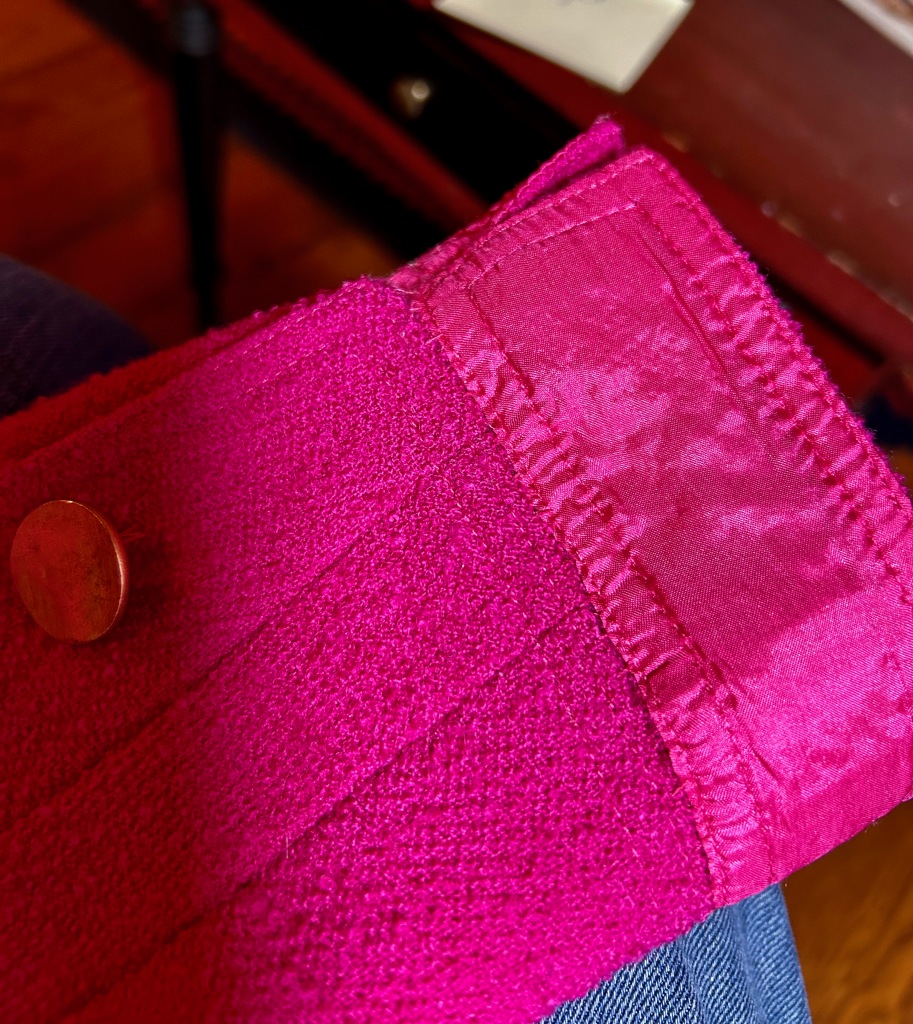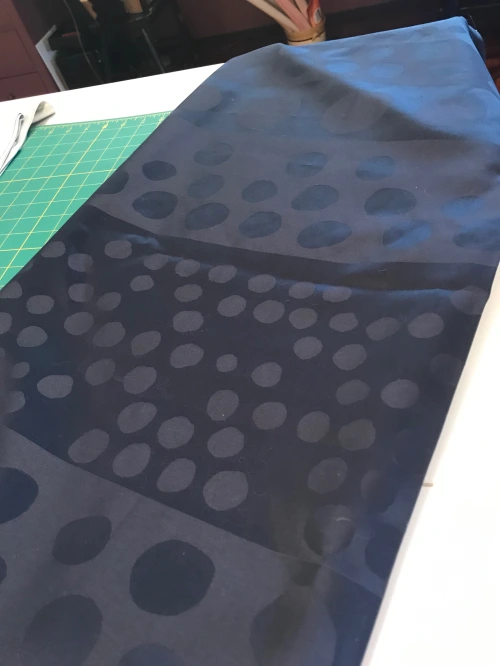With considerable thought!
I was a participant on Susan Khalje’s Paris Couture Tour in mid-March. I dutifully checked the expected weather in central and northern France for that time of year (Mr. Fifty Dresses and I were spending a week in Normandy and Brittany prior to the Paris component, which meant even more thought). Chilly, rainy, breezy were the parameters most often appearing in my weather search. Add to that the fact I did not want to look too Wintry nor too Springy, and, well, I was quite in a quandary!
Fortunately, Susan provided us with some guidelines for the type of clothing we would need. This included day wear for our scooting around Paris to see exhibits, fabric stores, specialty stores, museums, etc. She indicated that dress in Paris is “noted” so I took that to mean we needed to look “sharp” and “put-together.” We also would have two days with special visitors and demonstrations in the hotel. Again we didn’t need to be all dolled up, but we needed to look presentable. And then there were those special nights out. For those we would need dressy clothes – for a night at the Ballet at the Palais Garnier, a Gala dinner at a fancy restaurant, and an evening at a fashion show in a private Paris apartment.
Of course, I decided I needed a least a couple of new things to wear. And of course, that meant sewing. I started in mid-January, making a muslin for this dress (pictured in green):
Before I started on the actual dress, however, I thought I would resurrect a pink wool jacket I had purchased 20 years ago. Made in France, with some amazing details and handwork, the jacket had hung in my cedar closet for over 12 years, unworn. Its color and weight, however, seemed to be perfect for Paris in March.
When I tried it on, the shoulders were much too pronounced for today’s sensibilities. Undaunted, I knew I could easily remove the hand stitched lining from around the top and sides of the shoulder armhole area. I could see how the shoulder pads were configured and make adjustments. I plowed forward, expecting this project to take no more than one day.
No wonder those shoulders were so pronounced! There were four layers of padding, all custom cut and applied to each shoulder cap. I took out three layers for starters. I knew I needed some definition, and that seemed to do the trick. If I had been starting from scratch, I probably would have used even less padding, but this was acceptable to me.

What I had not anticipated was the fact that removing such a depth of shoulder padding had implications for the sleeve length. There was no way around the realization I was going to have to shorten the sleeves – or not wear this jacket in Paris – or anywhere, for that matter. Suddenly what promised to be a quick fix had morphed itself something much more time-consuming.
One of the beautiful details of this jacket was the applied tailored cuff on each sleeve. Shortening the sleeve was going to have to be in two parts.
I buckled down and removed the cuff on the first sleeve. I had determined I needed to reduce the sleeve length by 7/8 of an inch. I was worried the circumference of the sleeve end might “grow” enough to make the applied cuffs too skimpy. By now I was asking myself how I got myself into this? I was spending all sorts of time on this jacket when I had whole garments to sew. But it was too late to back down at this point. I cut off the necessary length from the sleeve and its lining, stitching them back together by hand. I then had to redo some top-stitching and found some thread which was a close match to the existing thread. Then I re-applied the cuffs by hand. Fortunately, they were split cuffs, so they had some “give” and molded nicely to the slightly larger circumference of the sleeve.
One down and one to go before I could respace the buttons above the cuffs.
With that jacket ready to go to Paris, I finally was able to turn my attention to that dress I wanted to make. Some of you may remember seeing this cotton sateen/jacquard fabric mentioned in a prior post. I had debated whether to make a dress or a long skirt with it, but ultimately decided on a dress as I thought I would get more wear out of it that way.
I thought this would be the perfect weight and fabric for early spring in Paris – not too heavy and not wintry looking. I envisioned wearing this to the fashion show which we would be attending one evening at a private apartment. So much for those plans! Our schedule that day did not allow us to return to the hotel to change clothes. We would have to wear our out-and-about day clothes into the evening.
I went to Plan B and wore this jacket I had made several years ago. I paired it with navy slacks, a pale pink blouse, and a scarf which matched the lining of the jacket. I carried along a change of shoes to look a little dressier and that was that!
So what about that navy blue polka-dotted dress? Yes, I did finish it.
I carried it all the way to France for 15 days and back home again and never wore it… More about it in a future post.













































































Something Old is New Again – and Again – and Again . . .
Coco Chanel said it herself, “I am against fashion that doesn’t last.” Could she possibly have known her Classic French Jacket would become such a lasting icon in the annals of fashion and style? Would she be amazed at how often her jacket has been imitated and copied – for decades now? And could she possibly have ever guessed the allure this style has for those of us who sew fashions for ourselves?
I really do not know the answers to these questions. From what I do know of this enigmatic woman, I can only guess that privately she may have suspected her creation had staying power far beyond most fashions. And certainly, as I have said before, “only Chanel is Chanel,” but what a blueprint she gave to those of us, either as individuals or as fashion companies, to copy and to change and to make her classic jacket into our very own.
I have been thinking about Coco Chanel quite a bit these days as I work on my fifth Classic French Jacket. Last Fall, about the time when I was getting ready to cut out my #5, The Wall Street Journal had this feature article on “Chanel-ish” jackets.
This article appeared in the Weekend Section of The Wall Street Journal, October 27 – 28, 2018. The center caption states: “8 Chanel-ish jackets that aren’t by Chanel, demonstrating the pervasiveness of Mademoiselle Coco’s enduring – and constantly reimagined – tweed jacket design.”
The featured jackets range in price from a “zara” version at $129 all the way up to a Gucci one at $13,500. I suspect few, if any, of these jackets are channel quilted as a real Chanel would be, but they all have that familiar, yet varying look that is so recognizable – the tweed or boucle fabric; the embellishment in the form of fringe, trim, and buttons; the boxy or minimally shaped profile; the symmetrical, balanced demeanor; and the ability to be worn casually or dressily.
Just about any women’s fashion catalog you open has examples which relate to Coco Chanel’s jacket. For example, in the span of just three pages of a recent Gorsuch catalog, four jackets have that classic Coco look.
A longer version of the classic jacket, its roots are immediately recognizable.
Another longer jacket which would look equally at home with a lace dress or, as shown, with denims.
And a traditional shorter jacket, shown in two colors. All these examples are in the Gorsuch GETAWAY catalog, Winter of 2019, pages 30-32.
Those of us who make our own Classic French Jackets are privy to the reality of hours of hand-sewing and unusual construction techniques inherent in one of these jackets. These are not fast projects. However, the pleasure of taking this classic design and having the stylistic freedom to choose and decide on all the components, while adhering to the “rules” of the basic style, make all those hours worthwhile.
Or so I tell myself! Here is where I am with my #5: quilting completed, lining fell-stitched in place as much as possible, sleeves assembled and ready to sew onto the body of the jacket.
Here the right sleeve is just pinned at the shoulder.
It is always a relief when I am sure the sleeves are going to match the plaid of the body of the jacket.
There is something about the shaping of these three piece sleeves, with vent, that is just so lovely.
I am still deciding on trim for this jacket, although I believe there is going to be fringe on this one. Perhaps a two-sided fringe with a pop of coordinating color between the edges. It would be fascinating to know what would Coco suggest. But then, it is such personal decisions which give these jackets their individuality.
I will be deciding on either Petersham ribbon or velvet ribbon as the underlay in the center trough of the fringe. It has been quite a search for the best color to use.
Coco Chanel was also known to have said, ”One cannot be forever innovating. I want to create classics.” Well, that she did with her classic jacket. And we are all the beneficiaries of her genius. Her idea, hatched in the 1920s, then defined to its current look in 1954, is an old idea which is continually reimagined and reformulated by those of us fortunate enough to sew. Merci, Mademoiselle Chanel!
23 Comments
Filed under Chanel-type jackets, classic French jacket, Coco Chanel, Fashion commentary, Uncategorized
Tagged as Chanel-inspired jackets, fashion sewing, quotes about fashion, Wall Street Journal Fashion coverage